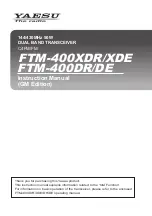
TM Page 32
Figure 8 - Installation of Transmitter with Shaft mounted Loop & Inductive Head IH2
FIT CAK KIT STEEL STRAPPING
THROUGH
SLOTS
ON
UNDERSIDE OF TRANSMITTER.
JOIN ENDS WITH SUPPLIED
TENSIONERS. DO NOT OVER
TENSION
STRAIN
GAUGE
INSTALLATION BENEATH
PROTECTIVE STAINLESS
STEEL SLEEVE
SINGLE TURN (2 TURNS FOR DIAMETER <60MM)
LOOP
FROM
SUPPLIED
COPPER
WIRE.
MINIMUM GAP AT ENDS. ENSURE AXIAL
ALGINMENT
SO
THAT
WIRE
REMAINS
BETWEEN
IH2
POLE-PIECES
DURING
ROTATION. TIE DOWN WIRE WITH 3 TURNS OF
POLYESTER TAPE
INDUCTIVE HEAD IH2
AERIAL
LOOP
SPACED
AWAY FROM SHAFT BY 3
TURNS (SEPARATE SINGLE
TURNS
TO
KEEP
THICKNESS CONSTANT) OF
20mm WIDE PVC FOAM
TAPE (SUPPLIED IN CAK
STRAIN
GAUGE
INSTALLATION
BENEATH
STAINLESS STEEL SLEEVE
5.1.3
Inductive Head IH2 or IH2/L with Power Pickup Loop Wound onto Shaft Using CAK Kit
In many applications, where shaft rotational speeds are not extreme and operating temperature below about +80°C, the
CAK kit may be used to attach the transmitter to the shaft, using steel strapping. A separate loop antenna is wound around
the shaft to pickup power and transmit the data signal - required materials are included in the CAK kit.
Figure 8 shows a typical installation and the following text "Suggested Installation Sequence" details installation.
5.1.4
Suggested Installation Sequence for Inductive Head IH2 or IH2/L with Transmitter & Power Pickup
Loop Using CAK Kit:
a) Decide upon desired location for the strain gauges and transmitter assembly, leaving space for the loop antenna - which
should be on the side of the transmitter away from the strain gauges. Locate the loop antenna where any shaft
displacement is at a minimum, thus avoiding large variations in the air-gap between inductive head and the loop. If the air-
gap becomes too great a signal drop-out will occur. Finally, space will be required to mount the inductive head - this
location should be as far away as possible from metallic components or surfaces.
b) Install gauges.
Note: As the zero back-off at the analogue output of the telemetry system is limited to
±
20% of the full scale measuring
range, it may be a good plan to incorporate trimming resistor pads into the strain gauge installation to facilitate balancing of
the bridge output to zero. This will not be necessary if strain levels are high (i.e. several mV output).
c) Calculate value for Rg (and Rcal if used) and install resistor onto transmitter.
d) Attach transmitter to shaft using CAK banding and tensioners, then loop antenna using 3 insulating foam tape layers - as
detailed in figure 4.2., to space the loop away from the shaft. If the loop diameter is 60mm or less, wind 2 turns, which will
give improved power pickup. Solder connect loop ends to appropriate transmitter pins.
e) Connect strain gauge leadwires to transmitter, also screen to housing (if screened cable used). When connecting strain
gauge signal leads check polarity to ensure that output voltage will read correctly (positive torque=positive V out) and not
backwards. Fit transmitter screening cover.
f) Position the inductive head IH2 using the supplied universal mounting bracket, as shown in figure 4.2., keeping the head
clear of metal components or surfaces, otherwise losses may reduce the transmitter supply voltage to less than the
minimum acceptable level of 5.8VDC Set the air-gap to 15mm and connect the head to the demodulator/decoder using
supplied cable. If the head tuning adjuster is altered, remember to lock the core in position using silicone rubber after
making any adjustment.
g) Carry out checkout as per section 6
Содержание TX31D/1/IFM
Страница 2: ...TM Page 2 ...












































